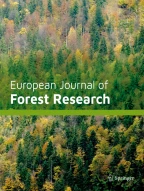Abstract
Using permanent sample-plot data, selected tree height and diameter functions were evaluated for their predictive abilities for major tree species in complex (multiple age, size and species cohort) stands of interior British Columbia (BC), Canada. Two sets of models were evaluated. The first set included five models for estimating height as a function of individual tree diameter, the second set also included five models for estimating height as a function of individual tree diameter and other stand-level attributes. The inclusion of the BAL index (which simultaneously indicates the relative position of a tree and stand density) into the base height–diameter models increased the accuracy of prediction for all species. On average, by including stand level attributes, root mean square values were reduced by 30.0 cm. Based on the residual plots and fit statistics, these models can be recommended for estimating tree heights for major tree species in complex stands of interior BC. The model coefficients are documented for future use.
Similar content being viewed by others
References
Boisvenue C (1999) Early height growth and regeneration: applicability of prognosis components to the southern interior of British Columbia. Master’s Thesis, University of British Columbia, Vancouver
Burkhart HE, Parker RC, Strub MR, Oderwald MR (1972) Yield of old-field loblolly pine plantations. School of Forestry and Wildlife Resources, Virginia Polytechnic Institute and State University, Blacksburg, Publication FWS-3-72
Curtis RO (1967) Height-diameter and height-diameter-age equations for second-growth Douglas-fir. For Sci 13:365–375
Flewelling JW de Jong RD (1994) Considerations in simultaneous curve fitting for repeated height-diameter measurements. Can J For Res 24:1408–1414
Froese K, LeMay V, Marshall PL, Zumrawi A (2001) PrognosisBC calibaration in the IDFdm2, Invermere Forest District: field sampling. Report to the B.C. Science Council, Burnaby
Gallant AR (1987) Nonlinear statistical models. Wiley, New York
Goldfield SM, Quandt RE (1965) Some tests for homoscedasticity. J Am Stat Assoc 60:539–547
Hamilton DA, Edwards BM (1976) Modeling the probability of individual tree mortality. USDA Forest Service Research Paper INT-185, Intermountain Forest and Range Experiment Station, Ogden, UT
Hasani BT, Marshall PL, LeMay V, Temesgen H (2001) Development of regeneration imputation models for the ICHmw2 in the vicinity of Nelson. Report to the BC Science Council, Burnaby
Huang S, Titus SJ (1994) An age-independent individual tree height prediction model for boreal spruce-aspen stands in Alberta. Can J For Res 24:1295–1301
Huang S, Titus SJ, Wiens DP (1992) Comparison of nonlinear height-diameter functions for major Alberta tree species. Can J For Res 22:1297–1304
Hui GY, Gadow K v (1993) Zur Entwicklung von Einheitshöhenkurven am Beispel der Baumart Cunninghamia lanceolata. Allg Forst Jagdztg 164 12:218–220
Kennel E (1972) Waldinventur und Holzaufkommensprognose für Bayern. Allg Forstz 615–616
Kramer H (1964) Die Genauigkeit der Massenermittlung nach dem “Reihenverfahren”—zu dem gleichlautenden Beitrag von Oberforstmeister von Laer. Forst Holzwirt 140–141
Lang A (1938) Bestandeseinheitshöhenkurven der Württembergischen Forsteinrichtungsanstalt. Allg Forst Jagdztg 168–176
Larsen DR, Hann DW (1987) Height-diameter equations for seventeen tree species in southwest Oregon. Oregon State University Forest Research Laboratory, Corvallis, Research Paper 49
Lencar C, Marshall PL (2000) Small tree height growth and stocking in the IDF dk1, dk2, dk3 subzones, Kamloops and Cariboo Forest Regions. Report to the Forest Practices and Research Branches, BC, Ministry of Forests, Victoria
Meidinger D, Pojar J (1991) Ecosystems of British Columbia. BC Ministry of Forests, Victoria
Nagel J (1991) Einheitshöhenkurvenmodell für Roteiche. Allg Forst Jagdztg 1:16–18
Oliver CD, Larson BC (1990) Forest stand dynamics. McGraw Hill, New York
Ratkowsky DA (1990) Handbook of nonlinear regression. Marcel and Dekker, New York
SAS Institute Inc. (1990) SAS/STAT User’s Guide, Version 6, vol 2, 4th edn. Cary, NC
Staudhammer C, LeMay V (2000) Height prediction equations using diameter and stand density measures. For Chron 76:303–309
Temesgen H, LeMay VM (1999) Examination of tree height and diameter increment models fitted for PrognosisBC. A report submitted to the Forest Practices Branch, BC Ministry of Forests, Victoria, BC
von Laer W (1964) Die Genauigkeit der Massenermittlung nach dem “Reihenverfahren”. Forst Holzwirt 139–140
Wykoff WR, Crookston NL, Stage AR (1982) User’s guide to the stand prognosis model. USDA Forest Service General Technical Report INT-133, Ogden, UT
Yang RC, Kozak A, Smith JHG (1978) The potential of Weibull-type functions as flexible growth curves. Can J For Res 8:424–431
Acknowledgements
We gratefully acknowledge the cooperation and financial support provided by the German Academic Exchange Program (DAAD), the British Columbia Ministry of Forests and University of British Columbia. We thank Drs. V. LeMay and P.L. Marshall for their comments on an earlier draft, and two anonymous referees for constructive comments. Part of this analysis was carried out when the lead author was a visiting scientist at the University of Göttingen, Germany.
Author information
Authors and Affiliations
Corresponding author
Rights and permissions
About this article
Cite this article
Temesgen, H., v. Gadow, K. Generalized height–diameter models—an application for major tree species in complex stands of interior British Columbia. Eur J Forest Res 123, 45–51 (2004). https://doi.org/10.1007/s10342-004-0020-z
Received:
Accepted:
Published:
Issue Date:
DOI: https://doi.org/10.1007/s10342-004-0020-z
